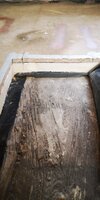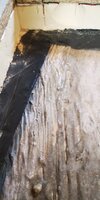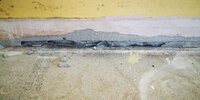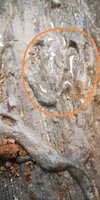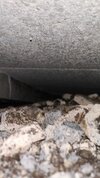You are using an out of date browser. It may not display this or other websites correctly.
You should upgrade or use an alternative browser.
You should upgrade or use an alternative browser.
Damp coming up through floor in new extension
- Thread starter Johnharold
- Start date
-
- Tags
- damp floor dpm new extension
Sponsored Links
- Joined
- 19 Sep 2023
- Messages
- 10
- Reaction score
- 1
- Country

The bumpy surface under the dpm must be the cement slurry,sorry, not the screed. The celotex is above, then the chipboard sitting on the celotex.
The shower wet room is next door, but the damp is on the opposite side of the room. It was built about 6 years ago.
The shower wet room is next door, but the damp is on the opposite side of the room. It was built about 6 years ago.
Yes.So it's a floating floor? Working from top down.
Chipboard
Celotex
DPM
Lumpy screed?
If correct, I'd be erring to bridged brickwork as damp perpetrator.
Attachments
- Joined
- 19 Sep 2023
- Messages
- 10
- Reaction score
- 1
- Country

Is that damp/moisture on the slab on post #17? (top right of post)
If so, I'm wondering if it's not a block & beam floor, but just sat on the earth.
Really the DPM could have done with being under the slab.
The surface is very bumpy and it can easily puncture the DPM.
The slits in the render outside will be doing nothing.
Did you take any photos of the construction or was it before your had the house?
If so, I'm wondering if it's not a block & beam floor, but just sat on the earth.
Really the DPM could have done with being under the slab.
The surface is very bumpy and it can easily puncture the DPM.
The slits in the render outside will be doing nothing.
Did you take any photos of the construction or was it before your had the house?
Sponsored Links
- Joined
- 19 Sep 2023
- Messages
- 10
- Reaction score
- 1
- Country

Yes, it's damp, it was actually a bit wet when I lifted the dpm this morning.
I only saw bits of the construction, but I did see the blocks and beam.
I thought the surface could puncture the dpm.
So little/no ventilation through those slits, would they need to be replaced with air bricks?
No photos of the build unfortunately.
I've removed the skirting. You can see the dpm just extending up
I only saw bits of the construction, but I did see the blocks and beam.
I thought the surface could puncture the dpm.
So little/no ventilation through those slits, would they need to be replaced with air bricks?
No photos of the build unfortunately.
I've removed the skirting. You can see the dpm just extending up
Attachments
Looking at the staining on the chipboard and mould on the wall, I'd be looking upwards for the cause of that amount of damp. You need a really thorough check of the roof, gutters, downpipes, fascias etc etc.
Alteratively it may have two membranes, the one you've seen above the slurry and another below it and/or the block & beam. It's possible it was sealed up while everything was wet, so what you're seeing are the few hundred litres that were sealed in on day one. Perhaps it just needs airing and drying out, and there isn't a cause of damp other than what was poured into the mixer on the day it was built.
Alteratively it may have two membranes, the one you've seen above the slurry and another below it and/or the block & beam. It's possible it was sealed up while everything was wet, so what you're seeing are the few hundred litres that were sealed in on day one. Perhaps it just needs airing and drying out, and there isn't a cause of damp other than what was poured into the mixer on the day it was built.
- Joined
- 19 Sep 2023
- Messages
- 10
- Reaction score
- 1
- Country

Wondering if it's condensation, the bottom of the B&B floor could be colder/more vapour and possibly there is no oversite.
Lack of ventilation could also contribute.
Can you take some pics of the outside wall please.
Do you know (doubt it) how much space there is from bottom of B&B floor to ground?
Lack of ventilation could also contribute.
Can you take some pics of the outside wall please.
Do you know (doubt it) how much space there is from bottom of B&B floor to ground?
You're very unlikely to get running liquid water rising up from the ground, unless it's a cellar.
Either this water was sealed in on day one when it was built or it's pouring in from somewhere, or you have a significant moisture source (e.g. steam room, shower, kitchen), and an absence of ventilation.
Either this water was sealed in on day one when it was built or it's pouring in from somewhere, or you have a significant moisture source (e.g. steam room, shower, kitchen), and an absence of ventilation.
Fair point.You're very unlikely to get running liquid water rising up from the ground, unless it's a cellar.
Either this water was sealed in on day one when it was built or it's pouring in from somewhere, or you have a significant moisture source (e.g. steam room, shower, kitchen), and an absence of ventilation.
Surely after 6 years it would be dry?
I don't know what you have, but often two membranes are used. One is under the insulation, the other above and the edges of both are trapped in the wall. Basically it's a giant cornish pastie. If there's a few hundred litres between them then it's not got anywhere to go, ever. It will dry out as fast as the contents of a bottle of water, i.e. never.
It's very difficult to understand without seeing it, this is merely a suggestion and something to consider.
It's very difficult to understand without seeing it, this is merely a suggestion and something to consider.
- Joined
- 19 Sep 2023
- Messages
- 10
- Reaction score
- 1
- Country

I think I've found the cause of the damp. I've broken some blocks out of the floor to see whats going on underneath, and found stone, soil, and bits of plasterbord, which I've started to clear out. It's all very damp, and hardly any, some places no gap for air movement.It looks like soil underneath that. I've core drilled three 110mm holes on either side of the outside wall for ventilation.
Attachments
The clearout looks like a good idea, but I doubt that's the cause of wet stains on the chipboard above.
DIYnot Local
Staff member
If you need to find a tradesperson to get your job done, please try our local search below, or if you are doing it yourself you can find suppliers local to you.
Select the supplier or trade you require, enter your location to begin your search.
Please select a service and enter a location to continue...
Are you a trade or supplier? You can create your listing free at DIYnot Local
Sponsored Links

